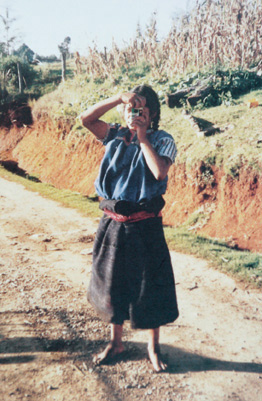
 Photo by Genaro
Santiz Gomez
Photo by Genaro
Santiz Gomez
Magazine
Winter/Spring 2002
Creencias:
the beliefs of our elders
by Carlota Duarte
The Chiapas Photography Project was founded in 1992
by Carlota Duarte to give the indigenous people of the Chiapas region
of Mexico the opportunity to creatively interpret their lives and culture.
In October, Ms. Duarte accompanied the project’s “Nuestra Comida”
exhibit to the Wabash campus.
The seed that became the Chiapas Photography Project grew from two sources.
As an artist, I wanted to see what people would and could express—and
what I could learn from them—when they were given a new artistic
tool and no pre-conceived notion as to how it ought to be used. Some of
my professional friends in places where I’d taught questioned me
on this. But I told them, “I don’t want to be a colonist. I’m
not going to tell these people ‘Here’s how it’s done.’
The point of the project is to let them discover their own ways to use
it” I knew from my own experience—for though I have my MFA in
photography, I was originally self-taught—that this was a great way
of learning.
My other motivation was justice. For centuries, indigenous people have
been subject to other people representing them. I came to see this very
clearly in 1985-86, when I was gathering data on pictorial collections
of Mexican history and culture. I saw how important indigenous origins
are for Mexico. But most of those representations of indigenous culture
are not by Indians, but by someone else. For this project, I decided,
the indigenous people should have their own voice.
The work of Maruch Satiz Gomez is just one example of how those voices
have been heard. Maruch was in our very first group. Only 17 then, she
already was a very good writer in her native language, tzotzil, one of
the Mayan languages.
Maruch had applied for a grant to fund a literary project called Creencias,
which means “beliefs.” She said, “I’m going to collect
from the elders our beliefs, because these are things that are being lost
or forgotten and need to be preserved for the next generation.”
Most of these creencias were ways of teaching children how to avoid illness
or danger. Some were folk cures. Almost all would disappear with the elders
who told them.
One day Maruch asked if she could use a little Fuji automatic camera I
owned. She came in the next Monday and wanted to show me her contact sheets.
When she began explaining them to me, I realized her idea was quite brilliant.
“I’ve written these down, but a lot of the people in my community
can’t read, so whatever I wrote won’t help them,” Maruch
told me. “But they might be able to read a picture in a book. So
I want to take pictures to go with the text.”
The result was the book, Creencias, and its photographs and text
introduced Maruch to the larger art world. Today, she’s internationally
famous. A gallery handles her work, and she’s had shows in Liverpool,
Johannesburg, Australia, Mexico City, and a collection of her work hangs
in the Reina de Sofia in Madrid.
Her lifestyle has not changed, even though she now has a relatively substantial
income. But her understanding of art, and of others, has grown.
I saw that most recently as she worked with Xunka Lopez Diaz, a young
photographer whose family had been expelled from her native village of
Chamula when she was four years old for embracing evangelical Christianity.
Her book was about her broken childhood, and her younger sister’s
mended childhood, and was a means of healing for Xunka. But she needed
Maruch’s assistance translating the book into tzotzil.
When she first learned of Xunka’s plight, Maruch told me that it
was right that Xunka’s family had been expelled. They’d broken
away from the beliefs of the community, so they should leave, she said.
But as the women worked together, Maruch saw the expulsion in a different
light—with deeper understanding and empathy that I believe comes
across in the writing of the book.
To see this young woman work so creatively to preserve her culture, even
while recognizing its weaknesses, has been very rewarding to me.
In many ways, this project is only coincidentally about photography.
Excerpted and edited from an interview with Carlota Duarte
Read the complete interview on WM Online: www.wabash.edu/magazine
Return to the table of contents
